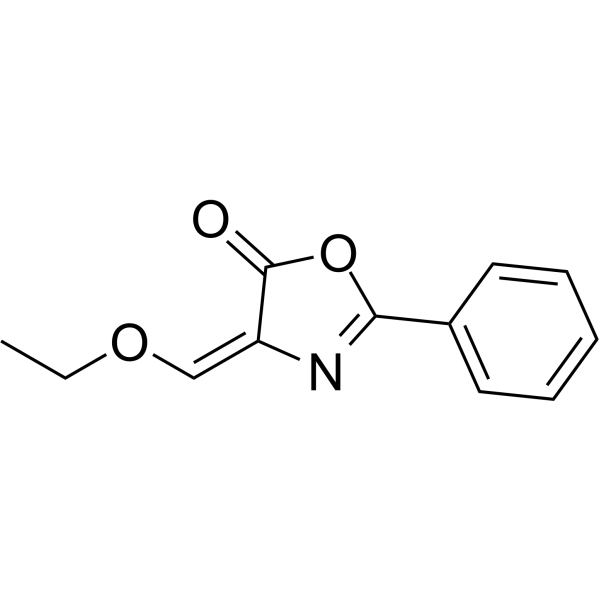Physicochemical Properties
| Molecular Formula | C12H11NO3 |
| Molecular Weight | 217.22 |
| Exact Mass | 217.074 |
| CAS # | 15646-46-5 |
| PubChem CID | 1712094 |
| Appearance | Gray to brown solid powder |
| Density | 1.18 g/cm3 |
| Boiling Point | 308.8ºC at 760 mmHg |
| Melting Point | 94-96 °C (dec.)(lit.) |
| Flash Point | 136.8ºC |
| Vapour Pressure | 0.000666mmHg at 25°C |
| Index of Refraction | 1.561 |
| LogP | 1.303 |
| Hydrogen Bond Donor Count | 0 |
| Hydrogen Bond Acceptor Count | 4 |
| Rotatable Bond Count | 3 |
| Heavy Atom Count | 16 |
| Complexity | 327 |
| Defined Atom Stereocenter Count | 0 |
| SMILES | CCO/C=C\1/C(=O)OC(=N1)C2=CC=CC=C2 |
| InChi Key | SJHPCNCNNSSLPL-NTMALXAHSA-N |
| InChi Code | InChI=1S/C12H11NO3/c1-2-15-8-10-12(14)16-11(13-10)9-6-4-3-5-7-9/h3-8H,2H2,1H3/b10-8- |
| Chemical Name | (4Z)-4-(ethoxymethylidene)-2-phenyl-1,3-oxazol-5-one |
| HS Tariff Code | 2934.99.9001 |
| Storage |
Powder-20°C 3 years 4°C 2 years In solvent -80°C 6 months -20°C 1 month |
| Shipping Condition | Room temperature (This product is stable at ambient temperature for a few days during ordinary shipping and time spent in Customs) |
Biological Activity
| Targets | IL-4 IL-13 TNFR1 |
| ln Vivo | Induction of colitis [1] 1. Method of preparation: Vortex acetone and olive oil at a 4:1 v/v ratio to create the sensitizing solution (1). To create a 3% (w/v) oxazolone-sensitized solution, dissolve 60 mg of oxazolone powder in 2 mL of this mixture. Use a gentle vortex to blend the mixture. Challenge solution (2) preparation: To make a 1% (w/v) solution, dissolve 20 mg of oxazolone in 2 mL of 50% ethanol. Use a gentle vortex to blend the mixture. Before used, the powdered oxazolone needs to be completely dissolved. 2. Procedure for the experiment: Sensitization pretreatment: Using electric scissors, scrape off around 2 cm by 2 cm of the mouse's back skin. Take care not to get any open wounds. Mice's naked skin should be given 150 μL of Oxazolone Sensitizing Solution (I). Take note that the control was a sensitizer free of oxazolone. Treatment induction: Give mice an intraperitoneal injection of ketamine/thiazide solution (80 μL/10 g) or use an isoflurane anesthesia device to anesthetize them by inhalation. Place the catheter in the mouse's colon, about 3–4 cm deep, right next to the anus. Attach the catheter's opposite end to a 1 mL syringe. Using the catheter, inject around 100 μL of Oxazolone Stimulating Solution (II) into the colon lumen for ten to thirty seconds. The mouse was kept vertically (head down) for 60 seconds following treatment. |
| References |
[1]. Oxazolone-Induced Colitis as a Model of Th2 Immune Responses in the Intestinal Mucosa. Methods Mol Biol. 2016;1422:253-61. |
| Additional Infomation | Immunologic adjuvant and sensitizing agent. |
Solubility Data
| Solubility (In Vitro) | DMSO : 100 mg/mL (460.36 mM) |
| Solubility (In Vivo) |
Solubility in Formulation 1: ≥ 2.5 mg/mL (11.51 mM) (saturation unknown) in 10% DMSO + 90% (20% SBE-β-CD in Saline) (add these co-solvents sequentially from left to right, and one by one), clear solution. For example, if 1 mL of working solution is to be prepared, you can add 100 μL of 25.0 mg/mL clear DMSO stock solution to 900 μL of 20% SBE-β-CD physiological saline solution and mix evenly. Preparation of 20% SBE-β-CD in Saline (4°C,1 week): Dissolve 2 g SBE-β-CD in 10 mL saline to obtain a clear solution. (Please use freshly prepared in vivo formulations for optimal results.) |
| Preparing Stock Solutions | 1 mg | 5 mg | 10 mg | |
| 1 mM | 4.6036 mL | 23.0181 mL | 46.0363 mL | |
| 5 mM | 0.9207 mL | 4.6036 mL | 9.2073 mL | |
| 10 mM | 0.4604 mL | 2.3018 mL | 4.6036 mL |
